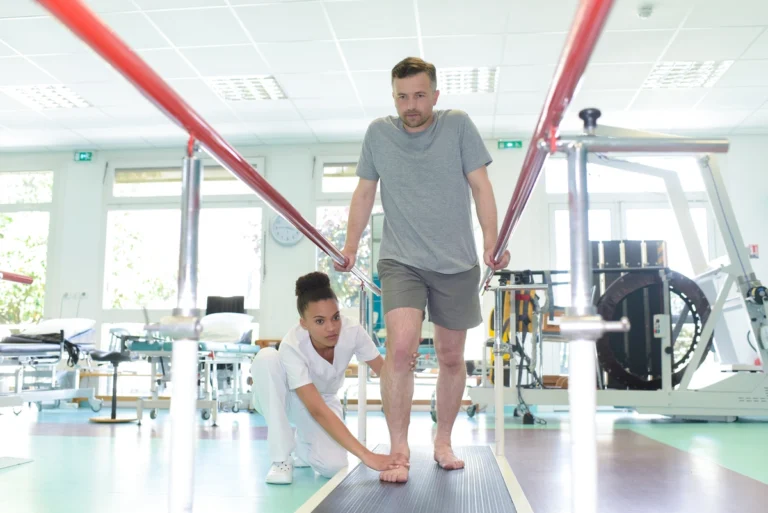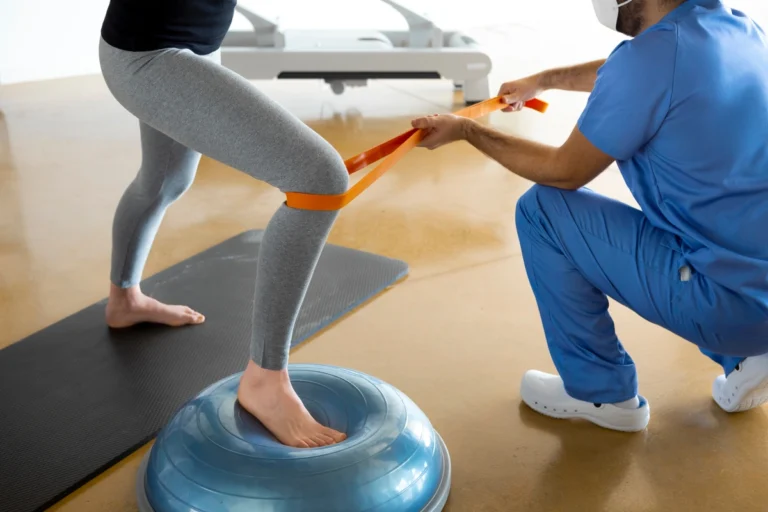Unlock Freedom of Movement with Myofascial Release and Deep Tissue Massage at Bull City PT
Feeling Restricted in Your Movements? Unleash Your Potential with Myofascial Release and Dive Back into What You Love!


Transform Your Well-being with Myofascial Release Therapy and Massage
Unlock the Potential of Low-Intensity Workouts
Myofascial Release is a specialized hands-on therapy designed to alleviate pain and restore motion by targeting the fascia—the connective tissue surrounding muscles. At Bull City PT, we embrace this gentle yet effective technique to treat a range of conditions, from chronic pain syndromes to acute injuries, and combine it with a traditional deep tissue massage. Our expert therapists apply sustained pressure into myofascial restrictions, unraveling tension and allowing your body to return to its natural, pain-free state.
This therapy is particularly beneficial for those experiencing persistent pain, limited flexibility, or those in recovery from physical traumas. Myofascial Release goes beyond traditional massage, focusing on releasing fascial constrictions to enhance circulation, promote relaxation, and facilitate healing. Whether you’re an athlete looking to improve performance, or someone seeking relief from the discomforts of daily life, our Myofascial Release services are tailored to meet your individual needs, guiding you toward holistic health and improved quality of life.
Symptoms Indicative of Myofascial Restrictions and massage:
- Persistent pain and soreness in muscles and joints
- Reduced range of motion and stiffness
- Sensations of tightness or areas of “knots”
- Postural imbalances and muscular tension
- Recurring injuries or prolonged recovery from trauma
Symptoms Indicative of Myofascial RWhy Consider Myofascial Release Therapy?estrictions and massage:
- Seeking relief from chronic pain conditions like fibromyalgia or back pain
- Looking to enhance flexibility and mobility
- Recovering from sports injuries or surgical procedures
- Desiring a holistic approach to tension and stress relief
Clinics offering treatment for Myofascial Release and Deep Tissue Massage
FAQ about Myofascial Release and Deep Tissue Massage
-
What Is Myofascial Release?
Myofascial release is a specialized physical therapy technique aimed at relieving tightness and pain in the myofascial tissues of the body. These tissues, known as fascia, are a web of connective tissues that surround muscles, bones, nerves, and organs, playing a critical role in overall structural support and function. If you are looking for myofascial release near me, you are likely seeking relief from conditions causing significant discomfort and mobility issues.
Definition of Myofascial Release
This therapeutic approach involves applying gentle, sustained pressure to the myofascial connective tissues to eliminate pain and restore motion. Practitioners often use their hands to carefully stretch and loosen the fascia, which in turn helps to manage access to the body’s connective tissues, improve blood flow, and promote the body’s natural healing processes.
Explanation of Fascia
The fascia is a continuous, uninterrupted web of connective tissue that extends from the top of the head to the tips of the toes. It’s responsible for maintaining the structural integrity of the body, providing support and protection. When the fascia becomes tight or restricted, it can cause pain, muscle tension, and decreased range of motion.
Typical Manual Therapy Techniques Used
Myofascial release therapy can involve various techniques, including direct and indirect methods. Just like a security plugin protects a website, the fascia acts as a protective layer for the body’s muscles and organs. Direct myofascial release involves applying pressure directly to the fascia to stretch it, while indirect methods use a gentler, lighter touch to allow the body to naturally release tension manually. Often, practitioners will combine these techniques for optimal results, customizing treatment according to individual needs.
Common Conditions Treated
Myofascial release is commonly used to treat conditions such as chronic pain, fibromyalgia, headaches, and much more. People suffering from sports injuries, car accidents, or post-surgical complications often seek the best myofascial release near Charlotte or near Cary or near Durham to relieve their pain and improve mobility.
-
Is Myofascial Release painful?
Myofascial Release focuses on gentle, sustained pressure, making it a generally comfortable and soothing experience. Some areas of deeper restriction may cause temporary discomfort, which quickly subsides as the fascia releases.
-
How does Myofascial Release differ from regular massage?
Unlike traditional massage techniques that primarily focus on muscles, Myofascial Release targets the fascia to address the root cause of pain and restriction, offering long-lasting relief and restoration.
-
What does a Deep Tissue Massage look like while at PT?
Deep tissue massage is performed in combination with other manual therapy techniques. Most injuries can benefit from manual therapy, however, your physical therapist uses these approaches in combination with other techniques to address your pain with the highest level of evidence-based research. Typically, deep tissue massage will be about an 8-15 minutes of your total visit.
-
How many sessions are needed to feel improvement?
Improvements can often be felt after just one session, with cumulative benefits observed over a series of treatments. The exact number of sessions varies based on individual needs and conditions.
-
Can Myofascial Release help with posture and alignment?
Absolutely. By releasing fascial restrictions, Myofascial Release can help correct postural imbalances, leading to improved alignment and reduced strain on the body.
-
Why do I only feel improvement for a few days after a massage?
Soft tissue massage can be referred to as a passive treatment. These passive treatments have been shown to have poor evidence in treating most injuries. A combination of massage and exercise is considered the gold standard in treating your ailments. At Bull City PT, we utilize exercise and massage to treat the root causes of your pain.
-
How Myofascial Release Works
Understanding the Mechanics of Therapy
Myofascial Release is a specialized form of manual therapy that targets the fascia, a complex network of connective tissue that surrounds and supports every structure in the body. When the fascia becomes restricted or scarred, it can cause pain, limited mobility, and a range of other symptoms. Myofascial Release works by applying gentle, sustained pressure to the affected areas, allowing the fascia to relax and release its tension. This can help to alleviate pain, improve range of motion, and promote overall well-being.
The therapy is based on the understanding that the fascia is a dynamic, interconnected system that responds to tension and stress. By releasing tension in one area, Myofascial Release can have a ripple effect, promoting relaxation and relief throughout the entire body. This holistic approach makes Myofascial Release an effective treatment for a wide range of conditions, from chronic pain and fibromyalgia to sports injuries and postural imbalances.
-
What Are the Benefits of Myofascial Release?
Myofascial release offers a multitude of benefits that go beyond immediate pain relief. Whether you’re located near Charlotte, Cary, or Durham, understanding these advantages can help you make an informed decision about incorporating this therapy into your health regimen.
Pain Relief
The primary benefit of myofascial release is pain relief. Chronic pain conditions such as fibromyalgia or lower back pain can be effectively managed through this technique. By targeting the fascia, a network of connective tissues that surrounds muscles, nerves, and organs, myofascial release helps to loosen areas that are tight and restricted. This in turn alleviates pain and helps individuals regain access to a more comfortable and active lifestyle.
Improved Mobility
Another significant benefit is improved mobility. Over time, stiff and restricted fascia can limit your range of motion, making daily activities challenging. The myofascial release addresses these issues by breaking down adhesions within the fascia, thereby restoring flexibility and movement. Whether you’re an athlete or someone dealing with age-related mobility issues, the benefits are extensive. Tracking your progress over time can be as precise as monitoring your computer’s time, allowing you to see tangible improvements in your mobility.
Enhanced Muscle Function Through Physical Therapy
Enhanced muscle function is another outcome that many experience after consistent myofascial release therapy. By reducing tension and improving blood flow to the affected areas, this technique helps to optimize muscle function. This can also contribute to quicker recovery times after intense physical activity or injury.
Stress Reduction
It’s also worth noting that myofascial release can be an effective tool for stress reduction. The therapy often incorporates slow, gentle pressure and sustained stretching, which can activate the body’s relaxation response. This not only alleviates physical tension but also promotes a sense of overall well-being and mental calm.
Long-term Health Benefits of a Holistic Approach
Last but not least, the long-term health benefits should not be overlooked. By maintaining flexible, healthy fascia, you’re less likely to experience chronic pain and mobility issues as you age. Regular myofascial release can help in preventing injuries and managing chronic conditions, making it a cornerstone for long-term health and wellness.
-
Physical Therapy and Myofascial Release
Integration with Other Therapeutic Practices
Myofascial Release is often used in conjunction with physical therapy to enhance treatment outcomes. Physical therapy focuses on improving mobility, strength, and function, while Myofascial Release targets the underlying fascial restrictions that may be contributing to pain and limited mobility. By combining these two therapies, patients can experience faster and more effective relief from pain and dysfunction.
In addition to physical therapy, Myofascial Release can also be integrated with other manual therapy techniques, such as massage and chiropractic care. This comprehensive approach can help to address the complex interplay of factors that contribute to pain and dysfunction, promoting optimal healing and recovery.
-
Where Can I Find the Best Myofascial Release Services Near Charlotte, Cary, or Durham?
Finding the best myofascial release services in your area requires a bit of research and consideration. Whether you’re in Charlotte, Cary, or Durham, here are some tips to help you locate the ideal practitioner and service.
Highly-rated Practitioners
Start by looking for practitioners who have high ratings and positive reviews online. Websites like Google, Yelp, and specialized healthcare review platforms can provide insights into the experiences of other individuals with these services. Keep an eye out for consistent praise about a practitioner’s effectiveness, professionalism, and customer service.
Locations that Offer Specialized Services
Several clinics and wellness centers in Charlotte, Cary, and Durham offer specialized myofascial release services. These places often have trained therapists who focus specifically on this technique, ensuring a higher standard of care. Ask if they provide initial consultations to discuss your specific needs and how their services can benefit you.
Tips for Choosing the Right Service
When selecting a myofascial release provider, consider factors such as the practitioner’s qualifications, experience, and approach to treatment, much like how a site owner manages their website. It is essential to feel comfortable and confident in their expertise. Inquire about their training and certifications, as well as how many years they’ve been practicing myofascial release.
Importance of Reviews and Recommendations
Online reviews are invaluable when choosing the right service. Pay attention to both positive and negative feedback to get a balanced view. Moreover, personal recommendations from friends, family, or healthcare providers can be incredibly helpful. Word of mouth often points you toward reputable practitioners who have been tried and tested by people you trust.
By following these guidelines, you’ll be well on your way to finding the best myofascial release near Charlotte, Cary, or Durham, ensuring that you receive top-notch care for your needs.
-
What to Expect from a Myofascial Release Session
Setting Expectations for Therapy
A typical Myofascial Release session lasts between 60-90 minutes and is tailored to the individual needs and goals of each patient. During the session, the therapist will use a combination of techniques, including sustained pressure and gentle stretching, to target the affected areas. Patients may experience a range of sensations during the session, including relaxation, tension, and release.
Before the session, patients will typically complete a brief intake form to provide information about their medical history, symptoms, and treatment goals. This information will help the therapist to develop a personalized treatment plan that addresses the patient’s specific needs.
During the session, patients are encouraged to provide feedback to the therapist, who will adjust the pressure and technique as needed to ensure comfort and effectiveness. After the session, patients may experience a range of benefits, including reduced pain, improved mobility, and enhanced overall well-being.
-
Are There Free Myofascial Release Options Available Near Me?
Are There Free Myofascial Release Options Available Near Me?
Finding free myofascial release services can be a challenge, but it’s not impossible. Here are some avenues to explore:
Community Health Centers
Many community health centers offer a range of services, including physical therapy and myofascial release. These centers are often funded by government programs or non-profit organizations and may offer services either for free or on a sliding scale based on your income. Checking with local health centers near Charlotte, Cary, or Durham could provide you with low-cost or free myofascial release options.
Special Events or Workshops
Keep an eye out for special events or workshops that focus on physical therapy or health and wellness. Many times, practitioners offer demonstrations and free introductory sessions at these events, giving you a chance to experience myofascial release without any cost. These events are often advertised in community bulletins and social media groups.
Non-Profit Organizations
Non-profit organizations focused on health and wellness sometimes offer free or discounted myofascial release sessions to community members in need. Organizations such as local YMCAs or specific health advocacy groups may have programs specifically designed to provide access to these beneficial services.
Insurance Coverage Tips
While myofascial release may not be entirely free, understanding your insurance coverage can significantly reduce out-of-pocket costs. Some insurance plans cover various aspects of physical therapy, including myofascial release, if deemed medically necessary. It’s advisable to contact your insurance provider and ask specifically about coverage for myofascial release services. Understanding your insurance coverage can feel like navigating administrative privileges, but it can significantly reduce your out-of-pocket costs.
Enhance your health journey with expert care at Bull City Physical Therapy’s Cary location. Our personalized care programs and advanced techniques are committed to your recovery and overall well-being. Book your appointment today and take the first step towards sustained health improvements.
Ready to Experience Myofascial Release?
Embark on a journey to enhanced well-being with Myofascial Release at Bull City PT. Our dedicated team is here to guide you through a personalized therapy experience focused on your total health and comfort.
Schedule Your Myofascial Release Session Today—Step into a World of Relief and Renewal.
Resources for Myofascial Release and Deep Tissue Massage





